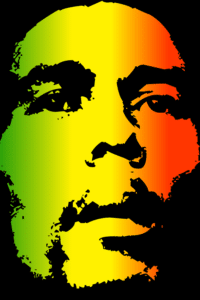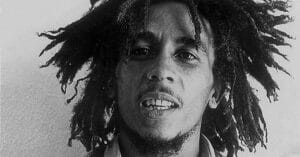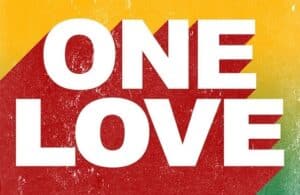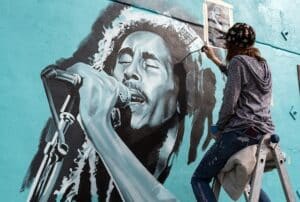“One good thing about music, when it hits you, you feel no pain.”
Those were the sentiments of Bob Marley, a man who believed that music had the power to bring us all closer together in peace and unity. Even if you are not a fan of reggae, you still know who Bob Marley was and chances are that you still like a few of his songs. Marley took a new and innovative sound that was mostly confined to the concert halls and radio waves of Jamaica and used it to create music that became not only international but timeless.

Early Years
Bob Marley was born Robert Nesta Marley on February 6, 1945, on his maternal grandfather’s farm in Nine Mile, a district of Saint Ann Parish in Jamaica, which was still a British colony back then. His mother was Cedella Malcolm, a local girl who was only 18 when she became pregnant with Bob. His father was a much more enigmatic figure in his life. His name was Norval Sinclair Marley and he was almost 60 years old when he met Cedella. Everyone called him “Captain,” even though it was unclear if he was ever actually a captain and when exactly he attained this title. Oh, and he was white, something which Bob grew to resent, especially when the other boys teased him for it.
Norval and Cedella got married soon after they found out she was pregnant but separated shortly after Cedella gave birth to Bob. From that point on, Norval became an ephemeral presence in his son’s life until he died aged 70 when Bob was only 10 years old. As an adult, Marley didn’t have many nice things to say about his dad. In fact, he barely acknowledged his existence. Friends of his said that Bob only kept a single reminder of his father – an old photograph of a white man on a horse.
During his childhood, Bob moved around for a bit, until 1957 when he and his mother moved to the slums of Kingston, in the government yard of Trench Town where “Georgie would make the fire lights” and they “would cook cornmeal porridge.” There, Cedella Marley made the acquaintance of a carpenter named Thaddeus Livingston, who already had eight children, including a boy about Bob’s age named Neville, although everyone called him “Bunny.”
Pretty quickly, Bob and Bunny became as thick as thieves, bonding over their shared love of music. They would spend many evenings singing together, using a homemade guitar that Bunny managed to MacGyver using an empty sardine can and a block of wood for the body, a length of bamboo for the neck, and insulation copper wire for the strings. It wasn’t exactly a Telecaster, but it got the job done.
The late 50s – early 60s were a quintessential time for Jamaica’s music scene, as local artists were busy exploring and defining the genres that would go on to become popular in the entire world: ska, rocksteady, and, of course, reggae. One of those artists was Joe Higgs, part of a successful duo called Higgs and Wilson. He also lived in Trench Town and his house often turned into the neighborhood dance hall, where local would-be musicians would turn up to show their stuff, as well as study under Higgs’s learning tree.
While attending one of his open-air music sessions, Bob and Bunny made the acquaintance of another young artist. His name was Winston Hubert McIntosh, although he went by Peter Tosh. Immediately, he grabbed Marley’s attention because he possessed a rare artifact among the poor musicians of Trench Town – an actual guitar, one that had not been improvised from scrap parts.
The three young men quickly struck up a friendship. They discovered that their singing harmonized really well together and decided to make some beautiful music together. Many others would join them at various points, but the core trio consisted of Marley, Bunny, and Tosh. All they needed now was a name for their new group. At first, they went by the Teenagers, but this didn’t stick. Then they changed it to the Wailing Rudeboys, but this wasn’t good enough, either, so it got switched again to the Wailing Wailers. Eventually, this got shortened simply to the Wailers.
Early Success

From the start, it was fairly obvious that Bob Marley was the breakout star of the group. Joe Higgs had taken the teenage musician under his wing, impressed with Marley’s dedication towards improving his craft. In 1962, Bob met Jamaican record producer Leslie Kong and managed to dazzle him by performing on the spot, in the middle of his shop, without accompaniment. Kong agreed to produce Marley’s first single, a song titled “Judge Not.” It received almost no airtime and only sold peanuts, but still, Bob Marley had released his first track at age 16. He recorded two more songs that year: “One Cup of Coffee” and “Terror.” Again, neither one set the charts on fire, but this did not discourage Marley.
Still, if the solo act wasn’t working out, maybe he would have more success with the Wailers. The following year, Marley met another one of the leading lights of Jamaica’s music scene – record producer Clement “Coxsone” Dodd. Whereas Joe Higgs taught young Bob to embrace his passion for music, Dodd taught him about how the music industry worked. He also saw promise in the Wailers, so in 1963, he helped produce their first single – “Simmer Down.” Unlike Marley’s previous solo efforts, this was a hit, and, by the start of 1964, it reached the top of the charts in Jamaica.
Two more hits followed: “It Hurts to Be Alone” and “Lonesome Feeling.” But just because the group was getting popular did not translate into any kind of financial bonanza. Quite the opposite, in fact. For the last few years, Marley had been homeless. His mother had married a man named Edward Booker, left Kingston, and relocated to Wilmington, Delaware, in America. Without her, Marley couldn’t afford a place to live, so most nights he slept in Dodd’s record studio, using an old door propped on top of some cinder blocks as a bed.
Unfortunately, even back then, the music business was as predatory as ever, and producers like Dodd kept most of the earnings since they provided the studio and the equipment, while the musicians received only a pittance, since there were always more starving artists out there, waiting to be exploited. Eventually, Marley concluded that the only way to make some real money from music was to start his own record company and control the entire production process. But, of course, this also required a large sum of cash to get going, something which Marley obviously didn’t have since he spent most nights sleeping on a door that wasn’t even his.
In 1965, Bob’s mother sent word from America, asking him to join her in Delaware where he could find a job and make some good money. It was awfully tempting, but at the same time, Bob had just met Rita Anderson, and the two of them fell in love. So they formulated a plan. On February 10, 1966, Bob and Rita got married. Afterward, Bob left for America, hoping to save enough money to return to Jamaica and start his own record company.
Marley resented being just another cog in the machine, feeling that everything was “too fast, too noisy, too rush-rush.” Even so, he proved to be a hard worker. He started out as a lab assistant at the DuPont Chemical Company, then he worked on the assembly line of a Chrysler factory. He also had a night shift at a warehouse and, occasionally, picked up part-time work as a dishwasher and parking lot attendant. At home, Marley often got into conflict with his mother over religion. A devout Christian woman, Cedella wasn’t happy that her son became a follower of the Rastafari movement, which also persuaded Marley to grow out his signature dreadlocks. Eventually, Bob had enough of America and returned to Jamaica in October 1966, less than a year after leaving.
While he was gone, the Wailers continued to perform, substituting Marley with one of Rita’s cousins, while Rita herself would later provide backing vocals as part of her own trio of female singers, the I-Threes. They had released their first album, titled The Wailing Wailers, although it was simply a compilation of earlier recordings. Ska had begun to decline in popularity in favor of the more relaxed and deliberate rhythms of rocksteady and reggae. Dodd kept stiffing the Wailers on payments, so the group left him and started their own label in 1967, Wailin’ Soul Records. But even though the band knew how to make records, they knew diddly squat about how to sell them, and their label closed down by the end of the year.
Fortunately for them, other offers appeared. The aforementioned producer Leslie Kong approached the Wailers, wanting them to record a new album using that up-and-coming reggae style. The end result was The Best of the Wailers, which was not a compilation album, despite the name. But then Kong dropped dead of a sudden heart attack soon after, so the Wailers were, once again, looking for a new producer. In 1970, they embarked on a two-year working relationship with Lee “Scratch” Perry, who produced two albums for the band: Soul Rebels and Soul Revolution Part II. But it was someone else who, for better or worse, would play a vital role in introducing the Wailers to the rest of the world – American singer-songwriter Johnny Nash.
Broke & Famous
By the early 70s, the music coming out of Jamaica had made its way stateside, and American artists had started coming to the Caribbean island, looking for new sounds and collaborators. One of them was Johnny Nash, a Houston-born singer who had been active since the mid-50s. Nash and his manager, Danny Sims, heard Marley play and approached him with a deal. Basically, Nash wanted some help getting that reggae sound right, and, in exchange, he promised new opportunities on the international stage.
Marley agreed and signed with Nash and Sims’s record label, JAD Records. His first gig was in Sweden, where he was supposed to help Nash score the soundtrack to a movie the latter was starring in. Internationally, it was released as Love Is Not a Game, although none of Bob’s music made it into the final cut.
From Sweden, Marley popped over to London where he worked with Nash and his band on his new album. Danny Sims who, by this point, was acting as Marley’s manager, sent for the other Wailers. He wanted them for Johnny’s album but lured them to London with promises of a national tour.
Well, as it turned out, the “tour” mainly consisted of secondary schools with the occasional club thrown in for good measure. Marley recorded a solo single during that time called “Reggae on Broadway,” but it flopped hard. And then, one morning, the Wailers woke up in their cold and crappy little apartment in Bayswater to discover that Nash and Sims had left England without telling them, trading the overcast skies of London for the sunny skyline of Miami.
Penniless and despondent, Bob at least discovered that he was fairly well-known in London’s music scene as Dodd had licensed several Wailers songs to another label called Island Records. Neither Marley nor the other band members saw any actual money from those licenses, but they were paid in exposure, something that according to modern influencers, is the most valuable commodity on this planet.
Actually, as it turned out, most places didn’t accept exposure, so the Wailers found themselves stranded in London in desperate need of cash. Using their connections, they eventually secured a face-to-face with Chris Blackwell, the founder of Island Records. He was convinced that a Jamaican act could make it big in London with the right guidance and he thought that maybe the Wailers could be that act. Well, to be more exact, he thought that Bob Marley could be that act. As far as Blackwell was concerned, everyone else was just there to fill space, but Marley had the talent and charisma to become a star. With that in mind, Blackwell agreed to loan them an advance so they could fly home and record a new album.
Back in warmer and more familiar surroundings, the Wailers got to work. After a few weeks, the album was done and Marley flew back to London with the masters. Under his supervision, Blackwell worked some of his own magic, overdubbing the tracks to combine the new and unique reggae sound with the rock vibe that played well commercially. He even got famed session musician Wayne Perkins to play lead guitar on a few of the tracks to make them more rock-and-roll.
The end result was Catch a Fire, released in 1973 and nowadays widely considered one of the greatest reggae albums of all time. It didn’t exactly sell like Gangbusters, but it did well enough for the Wailers to go on a tour of the UK and the US. During the American tour, the Wailers briefly opened for Sly and the Family Stone but got fired because the crowd liked them too much, and Sly didn’t want to get upstaged by a warm-up act.
Keen to capitalize on their newfound success, the group quickly got to work on another album, which was released later that same year. Titled Burnin’, it was another hit with the critics and included one of Bob Marley’s defining songs, “I Shot the Sheriff,” which was later covered by Eric Clapton. It seemed like Marley had finally arrived, but after the highs came the lows.
Smile Jamaica

Unfortunately, Blackwell’s tendency to focus on Marley didn’t sit well with the other two founders, Peter Tosh and Bunny Wailer, who also weren’t fans of doing international shows. On a late autumn tour of England in 1973, tensions between Tosh and Marley reached a boiling point. The two got into a bitter shouting match and the band unofficially disbanded. The Wailers were no more, at least not as we knew them. In 1974, Bob found a completely new lineup, which included his wife and the I-Threes, and got back to doing what he did best – making music. The label also started promoting the band as “Bob Marley and the Wailers,” just in case there was any lingering doubt over who was the centerpiece of the outfit.
Normally, losing almost the entire lineup would spell doom for a band, but Marley’s star was already shining too bright to be dimmed now. He spent most of the year working on new music and, in October 1974, Bob Marley and the Wailers released their seventh album Natty Dread. It was once again popular with the critics and sold the best out of all of their albums so far, especially in the UK. Most importantly, it included Marley’s greatest hit – “No Woman, No Cry.” A year later, the band put out a live album that also performed really well in the charts and contained the live rendition of “No Woman, No Cry” which went on to become the definitive version that we all know and love. In 1976, Bob Marley released his eighth album, Rastaman Vibration, which became his breakout record in the US, and his first one to enter the Billboard Top 10.
By that point, Bob Marley had officially “arrived,” as it were. His albums were selling well, concert demands were at an all-time high, and Rolling Stone magazine had just proclaimed the Wailers as “Band of the Year.” Nobody could deny that Bob Marley was the most popular reggae artist in the world or that he was one of the most beloved figures in Jamaica. So when Jamaican Prime Minister Michael Manley wanted to throw a concert to ease the rising political tensions, Marley seemed like the obvious choice for a headliner.
The concert was known as Smile Jamaica and it came at a time when the two main political factions in the country, the social-democratic People’s National Party, or PNP, and the conservative Jamaica Labour Party, or JLP, were engaged in a conflict that was starting to turn violent. Many felt that the country was a powder keg waiting to explode so there was a lot of pressure on this thing going smoothly.
Up until this point, Marley had always refused to take a political stance. He would say: “Rasta no go left, no go right, Rasta go straight ahead.” However, since the Jamaican Ministry of Culture was sponsoring the event, a lot of people saw it as a tacit endorsement of the ruling political party, the PNP, on behalf of Bob Marley. To make matters worse, the prime minister pulled off a real sneaky move by calling for a “snap election” on December 15, 1976, ten days after the show, effectively turning Smile Jamaica into a benefit concert for the PNP.
Marley was furious with Manley since he was promised that it would be “just music, no politics,” but you know the golden rule – the show must go on. Plus, Bob didn’t want to hurt the people of Jamaica over the devious actions of a few politicians who were looking to use him to score some extra points in the polls. However, by agreeing to go through with the concert, Marley unwittingly put himself in the crosshairs of some dangerous people who really didn’t want him to take to the stage.
It was December 3. Two days before the concert. Marley and the Wailers had been rehearsing at his home at 56 Hope Road. They were in the kitchen, taking a break, when two white Datsuns filled with six or seven gunmen pulled up in his driveway and made their way toward the house. They surrounded the building and opened fire. Fortunately, even though some of them were armed with automatic rifles, they displayed a Stormtrooper level of accuracy that miraculously resulted in zero fatalities. Bob Marley’s wife, Rita, was actually shot in the head while trying to exit the house, and even though she blacked out, she wasn’t seriously injured because the bullet grazed her skull. A family friend named Lewis Griffith took one to the gut, and Bob himself caught one bullet that scratched his chest before embedding into his arm. But worst of all was Marley’s manager, Don Taylor, who got shot five times. He was rushed to the hospital for emergency surgery, but he, too, survived the ordeal.
It has never been definitively established who was behind the hit. Most assume it was the JLP because that’s the most obvious answer, but no arrests were made in the case. Despite his injury, Marley elected to go through with the concert. As he got on stage in front of an exhilarated crowd of both PNP and JLP supporters, Marley said he would sing one song because he couldn’t strum his guitar. He and the Wailers then proceeded to play for 90 minutes, turning into the symbol of peace and unity that Marley always strived to become.
Legend

Following the concert, Marley went to recuperate in the Bahamas for a month. Afterward, he decided not to return to Jamaica, but to move to England in a “self-imposed exile.” He spent two years there, a time during which he recorded two albums: Exodus and Kaya. Both were well-received, especially Exodus which many consider Marley’s best studio album, containing the eponymous hit single, as well as other classics such as “Jamming,” “One Love,” and “Three Little Birds.”
When it was time for Marley to make his return to Jamaica, he did it for another show intended to quell the political civil war that was still brewing in the country. It was the One Love Peace Concert held on April 22, 1978, and it left behind a powerful, long-lasting image when Marley invited on stage the two political leaders, Michael Manley and Edward Seaga, and they all held up their hands together in a show of peace and unity. It didn’t last. Political violence in Jamaica continued, but hey, it was worth a shot.
Unfortunately, just as Marley’s international career was really taking off, he was hit by serious health problems. While on the European tour for Exodus, Bob hurt his right foot during a football game in Paris. He went to the doctor, who removed a jagged piece of nail, bandaged the wound, and asked Marley to stay off his feet. This was out of the question since Bob didn’t want to stop the tour. Instead, he wore heavy socks over his bandage and simply lived with the pain, even though he ended most shows with his right boot filled with blood.
In June 1978, the European leg of the tour had ended and Bob traveled to Delaware to spend some time with his mom and get ready for the US shows. However, his toe still had not healed. It got worse, to the point where Marley could barely walk anymore. He went to see a foot specialist who took a biopsy and returned with a dreaded diagnosis – cancer. It was an aggressive form of melanoma that was often fatal, but it could be treated if caught early. Contrary to a popular urban legend, the football injury didn’t cause Marley’s death, the cancer was already present.
After seeking a second opinion, Marley was left with two options. The best one was to amputate the toe. This was what his record label wanted since it had a short recovery time and it meant that Bob would be ready for the tour. But Marley didn’t want to lose his toe, so he went against his doctors’ advice and just removed the nail and adjacent flesh while trying to cleanse the wound as much as possible.
At first, it looked like it worked. Two months after the procedure, Bob Marley was given a clean bill of health and he was playing football again. The Exodus tour was postponed a few months but still became a massive hit, and afterward, Bob went into the studio and recorded two more albums: Survival and Uprising. But then, in 1980, while on the Uprising tour in New York City, Marley collapsed while jogging. He was taken to the hospital where he was basically handed a death sentence. The cancer had spread throughout his body, including his brain.
Despite the devastating news, Marley still wanted to perform, and he played one last concert in Pittsburgh in September 1980. After that, his health was too frail to continue. Marley traveled to Germany, where he tried an alternative treatment called Issels combination therapy but it did not manage to stop the cancer. When Marley realized he was dying, he wanted to be flown home to Jamaica, but his condition got worse during the flight and they had to make an emergency stop in Florida.
Bob Marley died in Miami, on May 11, 1981, aged 36, receiving a state funeral in Jamaica ten days later. The impact he had on music became evident a few years later when his Greatest Hits album was released. It still is, to this day, the best-selling reggae album of all time and one of the overall best-selling albums in history, simply titled Legend.






